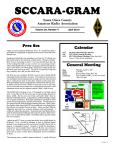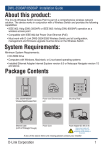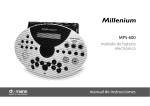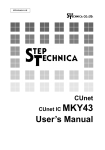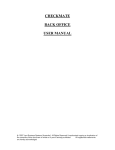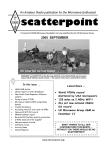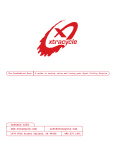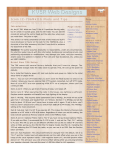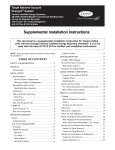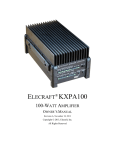Download January 2006 - Santa Cruz County Amateur Radio Club
Transcript
JANUARY 2006 Instant Messaging: History Repeats by Wayne Thalls, KB6KN Many think the miracle of instant communications is something new. After all, grandpa didn’t have the Internet or a cell phone. Like many things, what we are witnessing is evolution, not revolution. The CNN coverage of the West Virginia mine tragedy this week reminds me of the story of the birth of onthe-spot as-it-happens news broadcasting. In January of 1925 a Kentucky disaster closely paralleled the events of the past few days. A young cave explorer, Floyd Collins, became trapped in a previously unexplored cave. He was hoping to create a tourist attraction rivaling nearby Mammoth Cave. In recent years it has been determined that Sand Cave is actually a branch of Mammoth Cave. The nearest radio broadcast station was a couple hundred miles away in Louisville. The cave was several miles from the nearest telegraph office in Cave City. Two amateur radio operators (radio hams) came to the rescue. They set up a low-powered battery operated radiotelegraph station at the cave entrance. Another station was established at the terminus of the telegraph line. For four days, the two hams relayed the story of rescue efforts. It became a world event. The scene of the tragedy was a circus. An estimated 20,000 onlookers arrived. There were jugglers, medicine men, preachers and movie crews. Reporters were there from throughout the world. Jurisdictional disputes erupted between the local sheriff and the state guard. The incumbent governor and his rival in the upcoming election both arrived, seeking media exposure. For the first time, audiences in far away places were Continued page 5 California DXpedition Anyone? I received this note from BillVanAlstyne W5WV0 who is evidently a very keen operator on 6 meters and needs a few grids and counties in California. CM86 should not pose too much of a problem for us but what about CM79 ? —Ron W6WO Bill explains... I’ve researched this one a bit, just because it’s so improbable! CM79 is kind of the ultimate DXpedition grid. The only way you can get into it is by foot or boat, and boat isn’t really an option from a radio perspective. If you were to try to operate from the beach, the sheer mountain faces going almost straight up would make any kind of 6M propagation next to impossible. (You could probably get a signal out of there on 80/40M with an NVIS-type antenna, but that doesn’t count. Grid squares are VHF/UHF only.) There are not even any pack trails through this small sector. It is all trackless mountain/forest wilderness on a very steep slope. There is a pack trail that goes right past the north-east corner of it along the mountain ridge-line, but it never actually goes inside the grid square. To get down into the grid itself, you have to go off the trail, down the hillside about 30 meters through thick brush. At that point, from the corner of the grid square, you’re looking at a notinsurmountable uphill path to get a signal over the ridgeline and out to the east. Theoretically, you could shoot a 6M dipole up into the tops of the trees, and it would probably have enough height to put a halfway decent signal out to the east. That’s about the only realistic antenna option I can envision, but it just might work. (And it just might end up staying there forever. I doubt you could ever get it back down.) I don’t think anybody has ever successfully activated this grid square on 6M, and it is really the ultimate in hard-scrabble gridDXpeditioning. You would basically be operating a battery-powered radio (for as long as you had good batteries) from a treacherous 35-degree slope covered with trees and underbrush. A Yaesu FT-897 with internal battery packs would be a good choice here. I used to have one, but traded it. It would run about 25W on 6M under battery-pack power. You would probably have to have multiple battery packs recharged from a solar array up on the ridgeline trail where the sun could see it, or else schlep some large gel-cell storage batteries down the hill to the transceiver/antenna site (probably more practical in the long run, despite the significant weight). Doing it this way would actually allow you to run 100W from the FT-897 (or any other 100W 6M radio) if you needed it to make a QSO. The FT-897 is nice because it has its own self-contained battery packs, though. People HAVE gone there -- not as a ham radio thing, but rather as a GPS-based thing called the Degree Confluence Project (http: //www.confluence.org/index.php). The corner of this grid square is a Lat/Long “confluence” point (as are the corners of all grid squares). If you go to this website and look up the loggings for 40N 124W, you will find the records of several people/groups who have made the trek in and out (sans radios, of course). One of the photos you will see there was taken from the pack trail along the ridgeline, with a beautiful clear shot to the east. Close, but no cigar! It’s not in CM79. Mother Nature just didn’t cooperate here. For counties, I still need eleven: Del Norte, Trinity, Plumas, Sierra, Yuba, Alpine, Mono, San Benito, Kings, Tulare, and Continued page 5 CLUB MEETING FRIDAY JANUARY 20, 7:30 P.M. 2 JANUARY 2006 VP REPORTS Program Progress: It is great fun to meet up with and recruit as speakers, the upcoming slate of speaker/ hams. Many of which will be coming over the hill from Silicon Valley locations to our meetings. This month, we will have our own Cap Pennell, KE6AFE, speaking on new stuff applied to ARES communications. In February, we welcome Professor Bob Twiggs, KE6QMD, from Stanford University, who will present on his work, leading the Microsat community, inspiring the ham community in our Universities to build and launch small satellites, often no larger than a cube, 4” on a side. In March, we welcome Frank, W6QI, a VHF/UHF/Microwave contester who holds some world records as high as 23Ghz, who will talk about some of his adventures in the world of Microwave Contesting. In the queue, but not yet fixed as to Month, will be Jeff, AE6KS, and Eric, WA6HHQ. An old friend, Mark Hubbard, ex WA6LIU, may speak about radio data links soon. Mark was the repeater guy in Monterey many years ago, and now has grown as a successful data radio manufacturer, and now has the incredibly pleasant/headache of filling a single recent order for 30,000 (!) of his radios. I/the club is looking also for a Field Day Chair person, it’s not that far away, so think about getting ready for FD. By the way, I have been in the South Bay area for a couple of weeks, and after testing the link was unable to make the Monday night net, for a VEEP report. The VHF/UHF path is dynamic; what tested OK prior to the net, dropped out at the time of the net....Sorry Folks Give me your input as to what you want for future programs. Some club members have mentioned the utility/benefits of taping our meeting progams. I did this years ago at NPSARC meetings, and have archived some real good programs. The club needs someone to step up to be the Videographer/Historian, to set up a simple Video Recorder/Tripod system on meeting evenings to record Programs. I will check to see if maybe all the required gear might be available to us from Dominican, but would prefer someone who has access to a recorder. Maybe a student at a local college/Jr College could do this as a Multi Media project... In Monterey, a local TV (KION) station has a free Broadcasting Commnity service program that teaches the art, and provides equipment, loaned to ‘students’ All you have to do is register, (free) and Ron W6WO outlined plans to set up a station at his home in Kentucky, and asked for advice on crank-up towers as one of the first steps is to put in a tower base. A 330 degree clear horizon and a beam will no doubt make life interesting. We were pleased to welcome Mike N6IL today and to have Eric WA6HHQ join us. Mike brought his implementation of a tube type audio amplifier which unkind persons might describe as a rats nest while others would describe it as a piece of modern Dave W8FLL showed a broadband 300 Watt solid state amplifier made in China called a Paloma 300 HD. It could be argued that these are illegally aimed at CD users. The use of a heat sink was quite inventive. I am not suggesting what you may or may not do with this Dave but it would make quite a handy bedwarmer. Pat AA6EG came up with a new $25 gadget for internet linking that deserves (and will receive) more attention than it received today. Reed KG6RQH showed a kit for building a Rockmite radio that looks like a fun project. Bring it along to my QTH if you need any assistance. art, just the kind of object we enjoy Mike, thanks for bringing it. You efforts to defeat desensing of co-located radios at a repeater by enclosing one of them in a paint can is innovative. That should certainly remove the direct exposure. I will send you details of some filter designs in QEX using RG174 type coax that you might find useful. Bob K6XX showed details of a FTdx 9000 radio. At $13,000 it’s no wonder you had to go back to work Bob. Incidentally listing the menu options required 30 pages in the user manual. attend a few evening meetings, learning the various Professional Multimedia equipment. And then you can check out cameras, etc to produce your own projects.... Do this as an ATV project, An ATV’er could do the recording, at the same time, broadcasting the meetings to local areas, using ATV TX gear. Perhaps the club could accumulate a bunch of DVD records of programs, and sell them to interested parties, as a club fundraiser...Step Up! Step Up! Who’s gonna do it? —73, DX, de Pat Barthelow AA6EG We also discussed Kasie’s need for a pet locator and it seems there has been some local news on such devices. If anyone has more to offer please contact her at [email protected] Eric WA6HHQ is always good for the latest products and I was really impressed with his Casio 7.2 Mpixel camera Ex I 750. Eric mentioned the impending hazardous material restrictions about to be introduced in Europe which could mean the end of lead-based solder. This might affect not only Elecraft products but almost any other electronics. Lead is nasty stuff but hopefully there will be a phase out period to allow manufactures to adapt. Eric mentioned that our past President Richard KG6AXD is doing well in Idaho and can be reached via [email protected]. The choice of antenna wire is almost as controversial as the choice of antennas. Consider the Alpha Delta ad for a DX-OCF featuring 12 GA PVC coated cable comprising 65 strands each strand being individually tinned. The flexibility might have some merit but what about RF loss ? Skin effect losses on tin would be greater than for copper and surface oxidization of copper doesn’t actually increase loss does it? JANUARY 2006 When we turned on our expensive and beloved stereo set (CD/Tapes/Radio) the volume blasted our eardrums from its two speakers. I grabbed the control and tried to cut the sound before the speaker cones blew out. It was terrible, then got worse! I cut the power. After a few minutes of trouble-shooting, I decided that some limiting circuit was at fault. Where did I put the wiring diagram? How do I tear the plastic case apart without it cracking to pieces? Shop labor charges would exceed the value of a new set. A day later, my XYL Donna, AB6XJ, said, “Turn on the stereo.” I reached for the volume control and saw the knob lying on the table where she had placed it. The beautiful but cheap plastic knob had simply lost its grip on the pot control shaft. I compressed the attach point on the knob and reinstalled it. The set works fine. (Donna has always advised me to check the easiest things first.) Whatever happened to fine, old, knurled bakelite knobs with brass set screws? The Grumman Mallard tourist seaplane which crashed recently in Long Beach on takeoff was the result of a cracked wing spar (don’tcha hate that). The latest issue of Aviation Week had a photo of the spar area where the crack began. Two unexplained holes had been drilled in the spar at some forgotten time. One hole was apparently for a rivet. The other hole was drilled at an angle and adjacent to the rivet hole. Metal fatigue. No way yet to determine when, how, why, etc., but they appeared to be very old holes. The spar area is covered by wing skin and never removed. Sealant covered sections also. The Mallard is a beautiful airplane, vintage 1940s. I was crew chief on its smaller brother, the JRF-1Goose, circa 1948. NAS Alameda had one for photo recon purposes. They used to take it to Clear Lake for water landing practice. One thing we flight crew members (radiomen, flight engineers, pilots, navigators) always hoped was that the wings didn’t come unglued. Have been having fun working some CW contacts. WB6CRM, Bill, in West Sacramento, and I were on 40 mtrs. When I told him that my daughter lived near him in Fair Oaks, he came back saying that his dotter lived in La Selva beach. He was born in November, 1922. We are both Scorpios. Small world. On another day, KG6VPU and I chatted away. He was a helo mechanic working on police helos is Ontario, CA. He had to go to work or we would have swapped a few lies about airplanes. It doesn’t seem like things change too much. Was listening around the band and one op was sending good code at about 18 wpm but I had trouble copying him. The op he was working told him to standby until he could get a pencil and piece of paper. When he was asked why, the reply was that while he could copy the characters, the words were all run together. The first op was offended and said, “They are not!” They went back and forth a bit until the second op finally gave up and simply sent “73 SK.” There had been some fast discussion about how long each had been licensed hams (over 20 yrs for each). Golly. (Hey, I too thot the words were run together.) W1AW CW transmissions are fun to copy. The schedule can be downloaded from the ARRL website or taken from the monthly issues of QST Magazine. The bulletins are sent at 18 wpm several times a day. For copy practice, W1AW offers high and slow speed CW. The text is taken from the pages of QST if you want to see how well you are doing. While all indications are that CW will be relegated to the scrap pile with vacuum tubes and slide rules, it is still a fun and unique part of the hobby. 3 “U” as in What? or How I Learned To Stop Worrying And Love The Phonetic Alphabet Alpha, Bravo, Charlie, Delta—we all know a phonetic alphabetic, either the NATO or one of the others. But it was different for me during the 1970s when I was living in Alaska, in a bush village where the regional school district office was located. As secretary to the superintendent, one of my duties would be to keep communications open with our sixteen schools up and down the Kuskokwim River. One of the most important types of communications was relaying orders for such things as emergency generator replacement parts. If a part number was not relayed correctly, dire consequences could ensue, including frozen and burst water pipes. After being issued a Restricted Radiotelephone Operator Permit (without any test, as I recall, and without any reference materials or training on using a phonetic alphabet), I was put in charge of the radio. When transmitting part numbers, I would just grab a word out of my brain for any letter of the alphabet. One day, while relaying a generator part number, I came to a letter for which I couldn’t think of a word. I said, “U as in …” (long pause). Someone across the office said “underwear” and heck, I couldn’t think of a better word, so I said “underwear.” No, that wasn’t an earthquake striking the Alaskan Interior—it was dozens, maybe hundreds, of people monitoring the communications radios across the state, chuckling, chortling, guffawing, and rollicking at my “phonetic license.” —Kathleen KI6AIE Here is Reed KG6RQH building his tiny Softrock RX. More details on the project will be forthcoming. —W6WO JANUARY 2006 4 Peter 1 Island DX pedition. In early February, the biggest, possibly most difficult ham radio DXpedition in history will get underway, for as many as 16 days, if weather hazards don’t change their plans. Peter 1, off Antarctica, with a callsign of 3Y0X, will have perhaps only the 4th or 5th visit by humans in history, with the well seasoned crew of hams that is going there at the end of January/Early February. See some of these websites for information about Peter 1. http://www.hamradio.hr/ modules.php?name=News&file=article&sid=462 http://www.bigskyspaces.com/w7gj/ 3Y0XMoonbounceUpdate.doc http://www.strangeradioteam.com/inc/inc_news_ detail.asp?IDnews=157 http://8.3.8.118/peterone/main.htm Each of these participants going have anted up at least $16,000 to cover expenses. Some of you in the SCCARC may not be familiar with the art and science and fun of DXing, and dealing with pileups in order to work rare DX countries. Many may not ever care, or understand the attraction to this activity, thats OK too. If you ARE interested [in climbing the mountain...because it is there... to use a metaphor] then perhaps we can get together at/after club meetings/CAKE meetings, or after net time, to talk about this interesting ham radio activity, and how you can succeed in logging that rarest of the rare, 3Y0X callsign/country. Simply logging a single contact on any band or mode in the early hours that they open up will be a challenge, due to the massive pileups that will occur, but wouldn’t it be a thrill to succeed in the early hours, not by using big antennas or QRO power, but by finesse, and technique? On the other hand, QRO and big antennas deliver results, and their own kind of satisfaction, just as, say a 200 Hp Lotus Super Seven delivers to it’s operator. Either way, it can be very fun to do. Another challege is to log Peter 1 in all modes, all bands (they are even equipped to do Moonbounce) during their limited stay.. Whatever floats your boat, it should be fun, and lets talk it up this month, so that all who want to, can be succcessful in working Peter 1. —73, DX, de Pat Barthelow AA6EG DSL FILTERS HAM CLASS I have recently discovered a situation with DSL telephone noise filters where two different manufactures (E-Line and Excelsus Technologies)of filters to the same specification are not compatible. The vendors of the DSL filters are Verizon (Cambridge) and SBC from (Santa Cruz) . Both filters were made for the FCC part 68 rules and comply to Ringer Equivalence 0.1b. I save everything so while installing the Verizon system I inadvertently installed one of the old SBC filters on the telephone answering system. As soon as the modem was up and running the answering machine started misbehaving and recorded messages became very noisy for about 15 seconds obscuring the messages and then cleared up. Fortunately , for me, the DSL filters do not resemble each other and I noticed that the filter on the answering machine was the older SBC unit and guessed that it may be a problem as there did not seem to be a problem on the two phones and fax which had the Verizon filter. I will soon be teaching a class which will prepare people to pass the written exam for the Technician license, the entry-level amateur radio license offered by the FCC. No prior knowledge of electronics is required. I have been a licensed amateur radio operator since 1957, and I have taught amateur radioclasses before with good results. The class will be held on Wednesday nights, February 1 through March 8, 7:00to 9:00 PM. Location is the parish hall of St. Andrew’s Episcopal Church, Ben Lomond. Consequently I have a DSL modem and some line filters available for someone in the SBC service area if anyone is interested let me know. I miss you all in the Santa Cruz area and have not yet hooked up with a local group. We are still unpacking,sorting and a lot of the Ham gear is still among the missing. —73 N1IPP, James Koger [email protected] You can take the FCC exam on March 11,or at a later date if you wish. You will NOT have to learn Morse code to pass this exam. There is a charge of $15 for the required textbook, payable at the firstclass session. This textbook (titled “Now You’re Talking!”) was written specifically for this type of class. There will be a fee of $14 for taking the exam. This fee is payable on exam day to the examiners (not to me). The class size will be limited to 12 students so I can give each student individual help. You can call me at 336-8421 to obtain more information or to sign up for the class. —Ray Wentz, W6LPW January Meetings ARES/ACS Training and Updates We get the double whammy this month, Rich KI6EH and Cap KE6AFE, talking about amateur radio public service during emergencies. Recent exercises and events have shown how much good we all might do and how practice and preparedness help. Emergency communications stuff is worthwhile to all of us, and that perception is what preserves our amateur radio spectrum privileges. ARES/ACS Training, All hands, Thursday January 19, 7:30 p.m. Zayante Fire House (mid-county), Instructor: Rich Details, including what to bring, at our local ARES webpage http://ares.santacruz.ca.us . Then, the next night, there’s our Club Meeting, (Third) Friday January 20, 7:30 p.m. Dominican Hospital Education Center, upstairs A good opportunity to pay 2006 club membership dues in person! Cap will speak about “Emergency Communications topics, some New Stuff”. RadioFest 2006. February 25, 2006. Stillwell Hall, Ft Ord. RadioFest is a FREE Public Service and Family Event. It is sponsored by the “NPSARC” Naval Postgraduate School Amateur Radio Club. We will have many great events like: FLEA MARKET, VENDOR BOOTHS, HAM RADIO DEMOS, FREE LICENSE EXAMS, FANTASTIC SPEAKERS, DOOR PRIZES, and many more great Ham Radio activities........ Please visit our www page http: //www.radiofest.org/ After RadioFest you are invited to N6IJ Super Station Open House. http://www.n6ij.org/ JANUARY 2006 Loma Prieta Earthquake. The topic of “Tactical Net Procedures”, the most recent Santa Cruz County ARES Training Session presented December 8, 2005 at the Zayante Fire House, discussed proper procedures and protocols for tactical nets duringemergency operations. Subsequent to that training session Donald Kerns AE6RF steered us to his web site where he has posted 4 each approx. 15 min. audio “tapes” (in MP3 or RealAudio format) recorded soon after the 1989 Loma Prieta Earthquake; (See below). The recordings bring back a lot of feelings and emotions as for a few minutes we relive those traumatic days and nights following the Loma Prieta earthquake. The recordings were made by Eric Tofsrud, N6OIM, a Telecommunications Specialist with the US Geological Survey in Menlo Park. Our own Frank Wyatt N6FM is the Net Control during most of the recording and provides a fine example of what a good Net Control Station should be under pressure. Here is a brief explanation and history of the recordings from Eric’s webpage of those dramatic moments following the earthquake <http: //earthquakeadvisor.com/ articles/00032.html> http: //earthquakeadvisor.com/articles/ 00032.html): the excitement and fear as aftershocks happen during the net. Excuse the open microphone, it’s all I could do at the time. You will need an MP3 player to hear them. Most current operating systems come with a player that can decode MP3 files. If you have an older OS, you may need to get a player. Here are some of my post event notes. I started the tape about 10 minutes after the main event. Seconds before I pushed record, we had a Mag 5x aftershock. If you listen closely, you can hear my neighbor’s alarm sounding in the background. There were several more aftershocks that happened during the taping. One knocked my phone off the hook. You can hear the alert beeps. One aftershock interrupted the net due to net control having to leave the Sunnyvale Fire Station he was in. I pulled out my generator at dusk and we had the whole neighborhood at our house watching the news. We were without PG&E Power for 3 days after the event! The night of the quake around 11:00pm, I was called to open a Red Cross Shelter at the Senior Center in Mountain View. I checked people in all night, but in the morning the city condemned the building due to damage. We moved the shelter to the Rengstorff Park Recreation Center where I finished my shift. Hope you enjoy the audio files, ‘73 Eric N6OIM Editor’s Note: In the midst of colossal upheaval, it is the rare person who, recognizing historical significance, has both the opportunity and the presence of mind to do something about it. Eric Tofsrud is such a person. As the dust was still rising from buildings jolted apart by the Loma Prieta quake, Eric, a ham radio operator, powered up his equipment and hit the record button, preserving for history the voices and sounds of the events that followed. Eric volunteered with the Palo Alto, California Red Cross Disaster Action Team from 1983 to 1991. He works for the USGS. This is the record he made. You can find the recordings on either Eric’s web site at Below are four audio files that I recorded just after the Loma Prieta Earthquake. Hear damage reports being called into the W6ASH (SPECS) Ham Repeater’s Net Control station. Hear Thanks to Donald AE6RF for bringing these recordings to our attention. http://earthquakeadvisor.com/articles/00032.html http://earthquakeadvisor.com/articles/00032.html or at Donald Kern’s website at: http://www.kernsanalysis.com/loma/loma1.mp3 http://www.kernsanalysis.com/loma/loma1.ram http://www.kernsanalysis.com/loma/loma2.mp3 http://www.kernsanalysis.com/loma/loma2.ram http://www.kernsanalysis.com/loma/loma3.mp3 http://www.kernsanalysis.com/loma/loma3.ram http://www.kernsanalysis.com/loma/loma4.mp3 http://www.kernsanalysis.com/loma/loma4.ram —Rich, KI6EH Santa Cruz County ARES Training Coordinator 5 Instant Messaging cont. receiving eyewitness updates on the situation as events unfolded. Of course this was before the era of broadcast networks. The information was delivered to local newsrooms via telegraph. Through it all, the two amateur radio operators performed their emergency service without relief, until they were released after a temporary wire line was erected to Cave City. A rescue shaft was finally completed on Friday February 13--seventeen days after the entrapment began. Alas, Collins had died of exposure and starvation three days earlier. The carnival packed up and returned home. Ironically, the sole survivor of the 2006 disaster is a licensed ham. Randal L McCloy, Jr is KC8VKZ. He is clinging to life in a Pittsburgh hospital. Much of this information was acquired through my second passion, genealogy. My pursuit of family history has taken me to Mammoth Cave. No, I haven’t traced my ancestors back to the cavemen. My maternal grandmother was born near Mammoth Cave. My great grandparents, their parents, and other relatives are buried in cemeteries which are now within the boundaries of Mammoth Cave National Park. While conducting family research in the area, I visited the grave of Floyd Collins. The graves of my ancestors on the old family farm are essentially inaccessible. There are no access roads. Cal DX cont. Imperial. No one inside or outside CA has ever claimed the WACC award for working all CA counties on 6M. It has been done several times on 2M from within the state. The award is sponsored by the NCCC. Wonderful opening on 6M this evening! Had 53 QSOs, worked three new grid squares, including a very short path EM03 on sporadic-E backscatter (extreme weak signal CW) and a very long path to FM15 (eastern North Carolina) on double-hop sporadic-E, with good SSB signals. Most of the 53 Q’s were 5x9+. Very strong and long-lasting opening. Guys in the southeast US were working California on double-hop with strong signals. No CA propagation here, though, at least nothing that could get above the signal levels of the southeast US stations. Love this band... :-) 73, Bill / W5WVO SCCARC Board - 2006 President Vice President Secretary Treasurer Board K6BJ Trustee Christopher Angelos Pat Barthelow KG6DOZ AA6EG 688-3562 Kathleen McQuilling Mike Doern Allen Fugelseth Rich Hanset KI6AIE KM6IKE WB6RWU KI6EH 476-6303 477-1161 475-8846 438-0615 Bruce Hawkins AC6DN Vic Linderholm Royce Krilanovich AE6ID AC6Z MONTEREY BAY REPEATER ACTIVITY 476-5567 475-4798 Santa Cruz County ARC K6BJ 146.790- PL 94.8 Santa Cruz KI6EH 147.945- PL 94.8 Watsonville K6BJ 440.925+ PL 123.0 Santa Cruz • SCCARC Net Monday 7:30 PM 146.79- /147.180+ /440.925+ linked • SCCARC 10 Meter Net 28.308 MHz USB Monday 7:00 PM San Lorenzo WR6AOK 147.120+ PL 94.8 Ben Lomond Valley ARC • SLVARC Net Thursday 7:30 PM Loma Prieta RC WR6ABD 146.640-(PL 162.2) • LPRC Net Tuesday 8:00 PM Naval Postgraduate K6LY 146.97- PL 94.8 / 444.700+ PL123 (Linked) Monterey School ARC • NPSARC Net Wednesday at 8 PM on K6LY/R • Monterey ARES Net Wednesday 7:30 PM K6LY 146.970- (PL 94.9) ARES Nets SC County Wide ARES Tuesday 7:15 PM on AB6VS 440.550W6WLS 147.180+ AE6KE 146.835-(Linked repeaters / PL 94.8) Followed directly by • SLV ARES W6JWS 146.745-(PL 94.8) & WR6AOK 147.120+(PL 94.8) on alternate Tuesdays • South County ARES K6RMW 147.00+ (PL 94.8) • LPrieta ARES AE6KE 146.835- / AB6VS 440.550+ (Linked /PL 94.8) • Santa Cruz ARES K6BJ 146.79-/ (PL 94.8) • Newsline (Ham News) Broadcast Wednesday at end of NPSARC Net • Santa Clara Valley Section Traffic NET Tuesday 9:00PM 146.640- (PL 162.2) FOR MORE INFO SEE: http://www.k6bj.org/freq.html SANTA CRUZ COUNTY AMATEUR RADIO CLUB P.O. BOX 238 SANTA CRUZ, CA 95061-0238 CLUB MEETING FRIDAY JAN 20, 7:30 P.M. Membership Renewals Now Due If you haven’t already done so, it’s time to renew your Club membership for 2006. Annual dues are $25 for full members, $6 each for each additional member at the same mailing address, and $10 for full-time students age 18 or under. Dues may be paid in cash or check (payable to SCCARC) at regular Club meetings, or checks may be mailed to SCCARC, P.O. Box 238, Santa Cruz, CA 95061-0238. —Kathleen KI6AIE SCCARC Calendar of Events SCCARC Board Meeting 6:30 SCCARC Meeting Short Skip Deadline SCCARC Meeting Friday Friday Monday Friday Jan 20 Jan 20 Feb 6 Feb 17 MONTHLY MEETINGS. The SCCARC Meets at 7:30 PM, on the THIRD FRIDAY of the each month (except December). Meetings are at Dominican Hospital, 1555 Soquel Drive, Santa Cruz. Published 12 times per year. Free to members. Santa Cruz County Amateur Radio Club, Inc. Post Office Box 238 Santa Cruz, CA 95061-0238 Editor and Publisher Ron Baldwin, K6EXT (831) 419-1025 [email protected] Columnist: Art Lee, WF6P Writer: Ron Skelton, W6WO






